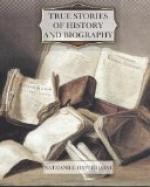For instance, if a man wanted to buy a coat, he perhaps exchanged a bear-skin for it. If he wished for a barrel of molasses, he might purchase it with a pile of pine boards. Musket-bullets were used instead of farthings. The Indians had a sort of money, called wampum, which was made of clam-shells; and this strange sort of specie was likewise taken in payment of debts, by the English settlers. Bank-bills had never been heard of. There was not money enough of any kind, in many parts of the country, to pay the salaries of the ministers; so that they sometimes had to take quintals of fish, bushels of corn, or cords of wood, instead of silver or gold.
As the people grew more numerous, and their trade one with another increased, the want of current money was still more sensibly felt. To supply the demand, the general court passed a law for establishing a coinage of shillings, sixpences, and threepences. Captain John Hull was appointed to manufacture this money, and was to have about one shilling out of every twenty to pay him for the trouble of making them.
Hereupon, all the old silver in the colony was handed over to Captain John Hull. The battered silver cans and tankards, I suppose, and silver buckles, and broken spoons, and silver buttons of worn-out coats, and silver hilts of swords that had figured at court, all such curious old articles were doubtless thrown into the melting-pot together. But by far the greater part of the silver consisted of bullion from the mines of South America, which the English buccaniers—(who were little better than pirates)—had taken from the Spaniards, and brought to Massachusetts.
All this old and new silver being melted down and coined, the result was an immense amount of splendid shillings, sixpences, and threepences. Each had the date, 1652, on the one side, and the figure of a pine-tree on the other. Hence they were called pine-tree shillings. And for every twenty shillings that he coined, you will remember, Captain John Hull was entitled to put one shilling into his own pocket.
The magistrates soon began to suspect that the mint-master would have the best of the bargain. They offered him a large sum of money, if he would but give up that twentieth shilling, which he was continually dropping into his own pocket. But Captain Hull declared himself perfectly satisfied with the shilling. And well he might be; for so diligently did he labor, that, in a few years, his pockets, his money bags, and his strong box, were overflowing with pine-tree shillings. This was probably the case when he came into possession of Grandfather’s chair; and, as he had worked so hard at the mint, it was certainly proper that he should have a comfortable chair to rest himself in.




